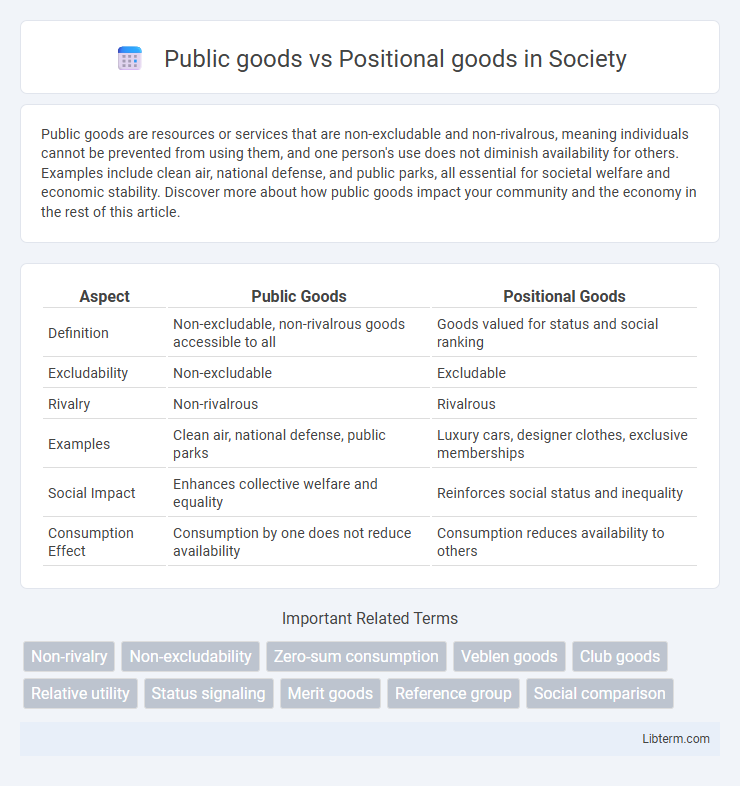Public goods are resources or services that are non-excludable and non-rivalrous, meaning individuals cannot be prevented from using them, and one person's use does not diminish availability for others. Examples include clean air, national defense, and public parks, all essential for societal welfare and economic stability. Discover more about how public goods impact your community and the economy in the rest of this article.
Table of Comparison
| Aspect | Public Goods | Positional Goods |
|---|---|---|
| Definition | Non-excludable, non-rivalrous goods accessible to all | Goods valued for status and social ranking |
| Excludability | Non-excludable | Excludable |
| Rivalry | Non-rivalrous | Rivalrous |
| Examples | Clean air, national defense, public parks | Luxury cars, designer clothes, exclusive memberships |
| Social Impact | Enhances collective welfare and equality | Reinforces social status and inequality |
| Consumption Effect | Consumption by one does not reduce availability | Consumption reduces availability to others |
Understanding Public Goods: Definitions and Characteristics
Public goods are defined by their non-excludability and non-rivalrous consumption, meaning individuals cannot be prevented from using them and one person's use does not reduce availability for others. Examples include clean air, national defense, and public parks, which provide widespread benefits irrespective of individual contribution. These goods often require government intervention for provision due to free-rider problems, distinguishing them from positional goods that gain value through exclusivity and social status.
What Are Positional Goods? Key Features Explained
Positional goods are items whose value is derived largely from their exclusivity and status symbol rather than intrinsic utility, such as luxury cars or designer clothing. Their key features include scarcity, competitive desirability, and social comparison, meaning their worth increases as fewer people own them. Unlike public goods that are non-excludable and non-rivalrous, positional goods are rivalrous and excludable, making them central to social status and prestige economics.
The Economic Importance of Public Goods
Public goods such as clean air, national defense, and public parks play a crucial role in economic development due to their non-excludable and non-rivalrous nature, ensuring widespread accessibility without diminishing availability. These goods address market failures by providing benefits that private markets often under-supply, fostering social welfare and stabilizing economic systems. Their efficient provision and maintenance are essential for promoting sustainable growth, equity, and collective well-being across societies.
How Positional Goods Shape Social Status
Positional goods derive their value primarily from exclusivity and social comparison, as owning rare or scarce items signals higher social status within communities. These goods influence social hierarchies by creating competition for limited resources that convey prestige, such as luxury cars, designer clothing, or prime real estate. The consumption of positional goods often leads to status-driven behavior, reinforcing societal divisions and emphasizing wealth-based differentiation.
Public Goods vs Positional Goods: Core Differences
Public goods are non-excludable and non-rivalrous, meaning their consumption by one individual does not reduce availability for others, exemplified by clean air or national defense. Positional goods, on the other hand, derive value primarily from their exclusivity and status symbol, such as luxury cars or designer clothing, where one person's consumption diminishes others' ability to enjoy the same good. The core difference lies in public goods fostering collective benefit without competition, whereas positional goods generate value through social comparison and scarcity.
Market Failures and the Provision of Public Goods
Public goods, characterized by non-excludability and non-rivalrous consumption, often lead to market failures because private markets struggle to provide them efficiently due to free-rider problems. Positional goods, which derive value from their relative status and exclusivity, do not suffer the same under-provision issues but can cause inefficiencies through over-consumption and negative externalities. The provision of public goods typically requires government intervention or collective action to address market failures and ensure socially optimal supply levels.
Inequality and the Role of Positional Goods
Positional goods exacerbate inequality by creating value based on social status and relative scarcity, often reinforcing social hierarchies and limiting upward mobility. Public goods, characterized by non-excludability and non-rivalry, tend to reduce inequality by providing widespread access and benefits to all members of society. The role of positional goods in perpetuating inequality underscores the importance of policies targeting consumption patterns and wealth distribution to mitigate social disparities.
Policy Challenges: Allocating Public and Positional Goods
Public goods, characterized by non-excludability and non-rivalry, pose policy challenges in ensuring efficient allocation without free-rider problems, while positional goods, valued for their scarcity and relative status, create dilemmas in managing inequality and social competition. Policymakers must balance equitable access to public goods like clean air or national defense with strategies that mitigate the exclusive nature of positional goods such as luxury housing or elite education. Effective allocation requires mechanisms that promote collective welfare for public goods and regulate consumption patterns of positional goods to prevent exacerbating social disparities.
Real-World Examples of Public and Positional Goods
Public goods like clean air, public parks, and national defense provide widespread benefits accessible to everyone without depletion or exclusion. Positional goods such as luxury cars, designer clothing, and exclusive real estate derive value primarily from their status and exclusivity, often sparking competition among individuals. The essential difference lies in public goods promoting collective welfare, whereas positional goods emphasize social ranking and individual prestige.
Future Implications: Balancing Public Welfare and Social Competition
Public goods, characterized by non-excludability and non-rivalry, require sustained investment to ensure equitable access and collective benefits, whereas positional goods, valued for their relative status, intensify social competition and can exacerbate inequality. Future policies must integrate strategies that promote the efficient provision of public goods while mitigating the zero-sum nature of positional goods to balance public welfare and social cohesion. Leveraging technology and innovative economic models can optimize resource distribution, fostering inclusive growth and reducing the societal costs of status-driven consumption.
Public goods Infographic

 libterm.com
libterm.com